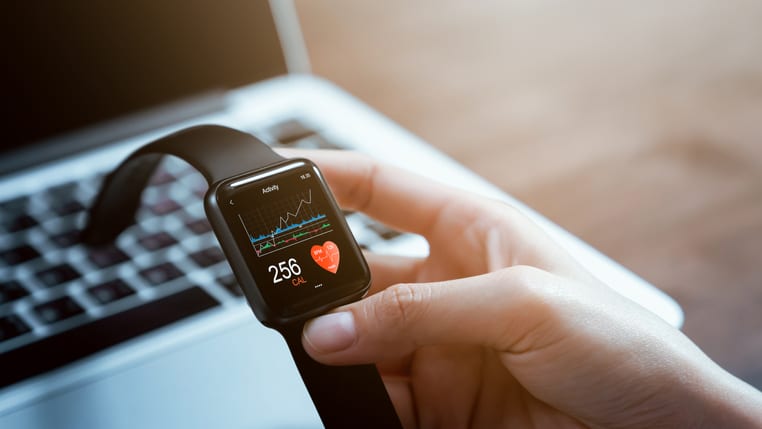Outfitting workers with devices that alert them to efficiencies and dangerous situations isn't new. In manufacturing plants, warehouses and other settings, wearables monitor workflow efficiencies and warn employees if they are too close to a hazard.
But wearable technology is also proving useful to support health and wellness. It can help track movement like bending over and reaching, and essentially create an ergonomic map, said Shelia Stafford, CEO of TeamSense, a productivity and connection platform for hourly workers.
An ergonomic map, she explained, could summarize data collected by wearables to help highlight risks to a person's health due to things like repeated movements and posture at work. For example, wearables could track how a warehouse or factory worker is bending over to lift materials.
"If they are lifting with their back instead of their legs, then they would be at a higher risk of throwing out their back doing this repeatedly," she said. "This would be a trend highlighted on the ergonomic map to indicate a potential risk."
Having this type of data helps inform a company's decisions around how to change the workflow to make each team member more comfortable. For example, car manufacturers like BMW and Audi are testing an "exoskeleton" that is said to reduce back strain by 20 percent to 30 percent.
Here's a look at how organizations are bringing technology into the workplace and encouraging employee buy-in.
Wearables on the Rise
According to the Pew Research Center, 21 percent of Americans say they regularly wear smartwatches or fitness trackers. Use of wearables outside the office opens doors of opportunity at work. Some companies have provided employees with health trackers to leverage insurance discounts and to incentivize staff to embrace healthier lifestyles.
The pandemic forced organizations to think creatively about health-based wearables. Janet Mertens, director of research at The Josh Bersin Co., a global firm that offers HR research and advisory services, noted that, in early 2020, Ford Motor Co. gave workers buzzing wristbands to indicate when they were within 6 feet of another person.
"Their goal with this program was to help them reopen their facilities in a safe way while meeting local health regulations," Mertens said.
The Future of Wearables
Companies see wearables as a significant investment area during the next three years. The 2021 MHI Annual Industry Report found 26 percent of respondents planned to set aside funds for wearable technologies. More than 1,000 supply chain professionals participated in the survey by MHI and Deloitte.
Stafford pointed out an initiative by Walmart that gave each of the company's 740,000 employees a smartphone for personal use as well as to communicate with co-workers, manage their work schedules and perform some work tasks like moving inventory through the store. Another example is the U.S. Department of Homeland Security's request for proposals to "find innovative technological solutions that will improve overall health and wellness."
"Having wearable technology, like a smartphone, can add a much-needed connection and a line of communication during the workday and beyond," Stafford said. "Wearables can be linked to efficiency by helping employees get answers to questions quickly or providing a task-based checklist."
Getting Buy-In
Employees may feel wearable technology is like having Big Brother watching over them. No one likes to be micromanaged. Helping employees understand how the devices will be used to their benefit can help employers avoid an adverse reaction.
"Employers should ensure that the value and impact of any wearable is clear and communicated to the employees being asked to use them," Mertens said. "Whether the wearable collects personal health data to promote individual wellness or helps prevent injury on the job, it's important for workers to understand the impacts and benefits to their life and work."
As an employer, start by identifying your goals for bringing wearable devices into your business. Employees will want to know how the technology can benefit their team and themselves as individuals.
Invite employees to get involved with the process by experiencing the device through a trial period and then giving feedback.
"Consider the audience and understand both the pros and cons of the technology from the team member's point of view," Stafford said. "Call out the elephant in the room. Privacy is usually the most significant. Address their concerns, and then discuss why the technology is beneficial and how those benefits will impact the employees and not just the company."
Privacy Concerns
As the Internet of things expands, privacy concerns are also increasing—and in some cases, the devices may be illegal when used for monitoring employee health. Regulations vary widely from one country to the next, and even state to state, so it's important to know local policies.
While the Americans with Disabilities Act allows periodic monitoring in specific scenarios, continuous observation is a violation.
"What we're seeing is employers using data at an aggregate level, maybe down to a group of 10 people," Mertens said. "Tracking at an individual level can go wrong. We are all too familiar with security breaches. One of the many responsibilities associated with an HR role is that of being a data steward, and it's essential to be transparent with employees how the data is going to be used."
Katie Navarra is a freelance writer in New York state.
An organization run by AI is not a futuristic concept. Such technology is already a part of many workplaces and will continue to shape the labor market and HR. Here's how employers and employees can successfully manage generative AI and other AI-powered systems.




